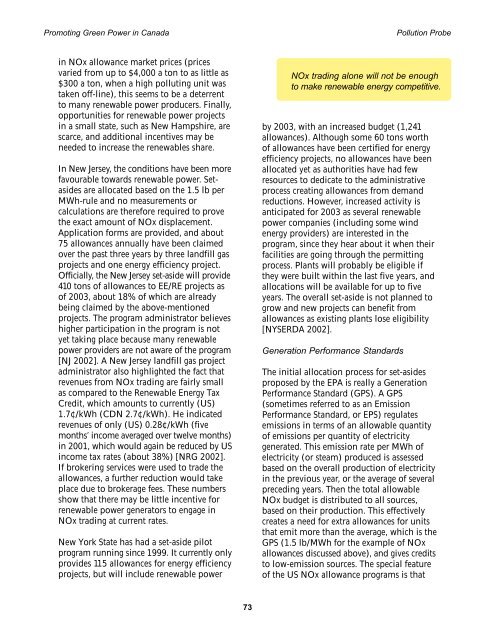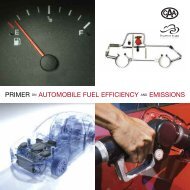Promoting Green Power in Canada - Centre for Human Settlements
Promoting Green Power in Canada - Centre for Human Settlements
Promoting Green Power in Canada - Centre for Human Settlements
- No tags were found...
Create successful ePaper yourself
Turn your PDF publications into a flip-book with our unique Google optimized e-Paper software.
<strong>Promot<strong>in</strong>g</strong> <strong>Green</strong> <strong>Power</strong> <strong>in</strong> <strong>Canada</strong> Pollution Probe<strong>in</strong> NOx allowance market prices (pricesvaried from up to $4,000 a ton to as little as$300 a ton, when a high pollut<strong>in</strong>g unit wastaken off-l<strong>in</strong>e), this seems to be a deterrentto many renewable power producers. F<strong>in</strong>ally,opportunities <strong>for</strong> renewable power projects<strong>in</strong> a small state, such as New Hampshire, arescarce, and additional <strong>in</strong>centives may beneeded to <strong>in</strong>crease the renewables share.In New Jersey, the conditions have been morefavourable towards renewable power. Setasidesare allocated based on the 1.5 lb perMWh-rule and no measurements orcalculations are there<strong>for</strong>e required to provethe exact amount of NOx displacement.Application <strong>for</strong>ms are provided, and about75 allowances annually have been claimedover the past three years by three landfill gasprojects and one energy efficiency project.Officially, the New Jersey set-aside will provide410 tons of allowances to EE/RE projects asof 2003, about 18% of which are alreadybe<strong>in</strong>g claimed by the above-mentionedprojects. The program adm<strong>in</strong>istrator believeshigher participation <strong>in</strong> the program is notyet tak<strong>in</strong>g place because many renewablepower providers are not aware of the program[NJ 2002]. A New Jersey landfill gas projectadm<strong>in</strong>istrator also highlighted the fact thatrevenues from NOx trad<strong>in</strong>g are fairly smallas compared to the Renewable Energy TaxCredit, which amounts to currently (US)1.7¢/kWh (CDN 2.7¢/kWh). He <strong>in</strong>dicatedrevenues of only (US) 0.28¢/kWh (fivemonths’ <strong>in</strong>come averaged over twelve months)<strong>in</strong> 2001, which would aga<strong>in</strong> be reduced by US<strong>in</strong>come tax rates (about 38%) [NRG 2002].If broker<strong>in</strong>g services were used to trade theallowances, a further reduction would takeplace due to brokerage fees. These numbersshow that there may be little <strong>in</strong>centive <strong>for</strong>renewable power generators to engage <strong>in</strong>NOx trad<strong>in</strong>g at current rates.New York State has had a set-aside pilotprogram runn<strong>in</strong>g s<strong>in</strong>ce 1999. It currently onlyprovides 115 allowances <strong>for</strong> energy efficiencyprojects, but will <strong>in</strong>clude renewable powerNOx trad<strong>in</strong>g alone will not be enoughto make renewable energy competitive.by 2003, with an <strong>in</strong>creased budget (1,241allowances). Although some 60 tons worthof allowances have been certified <strong>for</strong> energyefficiency projects, no allowances have beenallocated yet as authorities have had fewresources to dedicate to the adm<strong>in</strong>istrativeprocess creat<strong>in</strong>g allowances from demandreductions. However, <strong>in</strong>creased activity isanticipated <strong>for</strong> 2003 as several renewablepower companies (<strong>in</strong>clud<strong>in</strong>g some w<strong>in</strong>denergy providers) are <strong>in</strong>terested <strong>in</strong> theprogram, s<strong>in</strong>ce they hear about it when theirfacilities are go<strong>in</strong>g through the permitt<strong>in</strong>gprocess. Plants will probably be eligible ifthey were built with<strong>in</strong> the last five years, andallocations will be available <strong>for</strong> up to fiveyears. The overall set-aside is not planned togrow and new projects can benefit fromallowances as exist<strong>in</strong>g plants lose eligibility[NYSERDA 2002].Generation Per<strong>for</strong>mance StandardsThe <strong>in</strong>itial allocation process <strong>for</strong> set-asidesproposed by the EPA is really a GenerationPer<strong>for</strong>mance Standard (GPS). A GPS(sometimes referred to as an EmissionPer<strong>for</strong>mance Standard, or EPS) regulatesemissions <strong>in</strong> terms of an allowable quantityof emissions per quantity of electricitygenerated. This emission rate per MWh ofelectricity (or steam) produced is assessedbased on the overall production of electricity<strong>in</strong> the previous year, or the average of severalpreced<strong>in</strong>g years. Then the total allowableNOx budget is distributed to all sources,based on their production. This effectivelycreates a need <strong>for</strong> extra allowances <strong>for</strong> unitsthat emit more than the average, which is theGPS (1.5 lb/MWh <strong>for</strong> the example of NOxallowances discussed above), and gives creditsto low-emission sources. The special featureof the US NOx allowance programs is that73
















